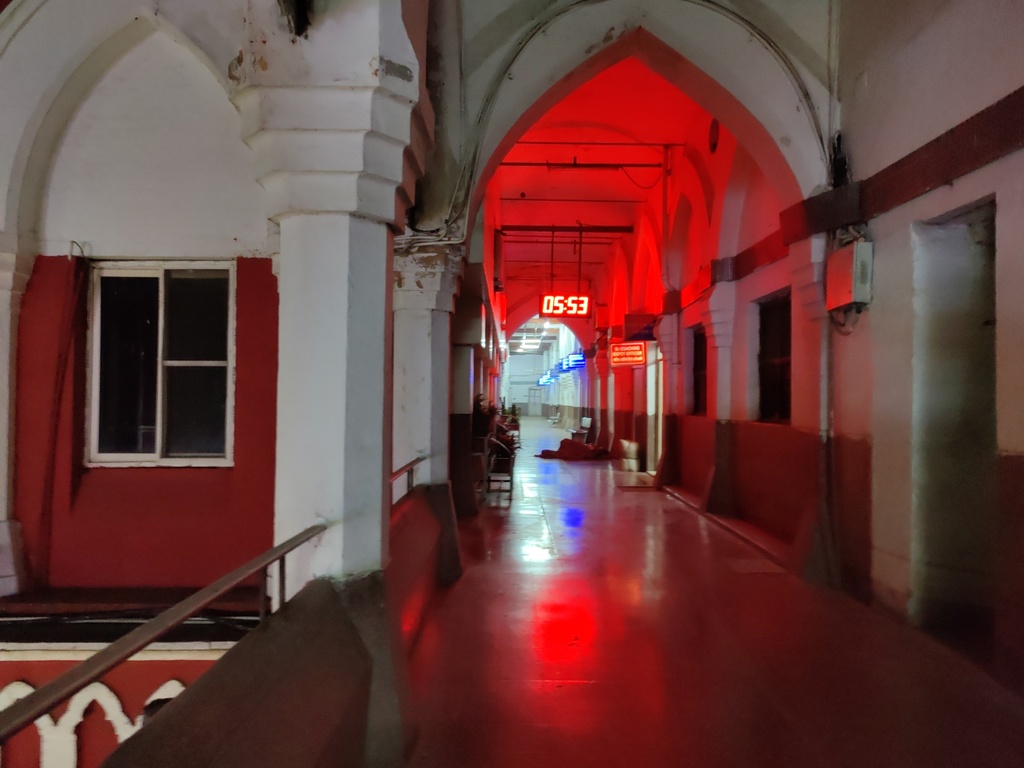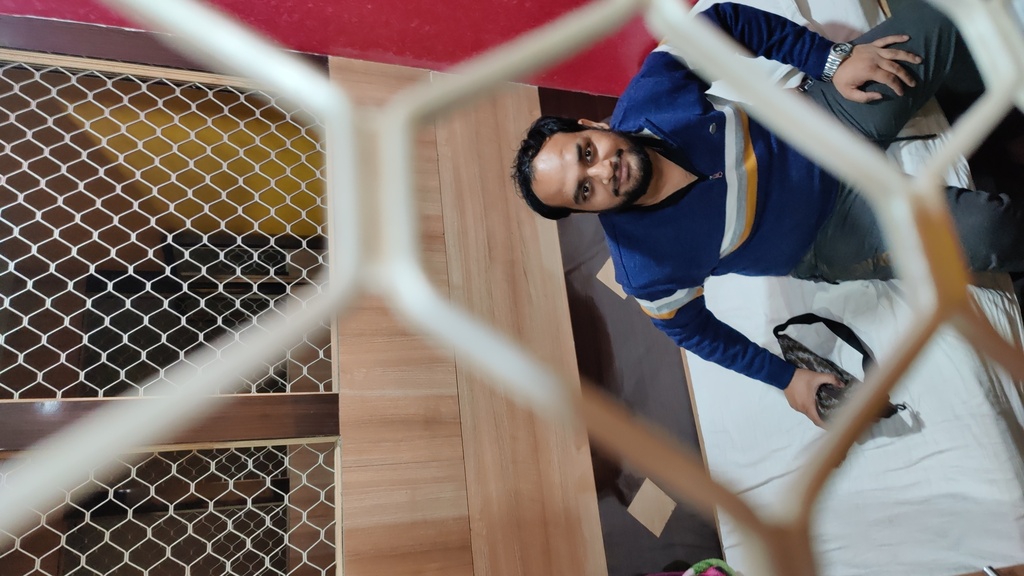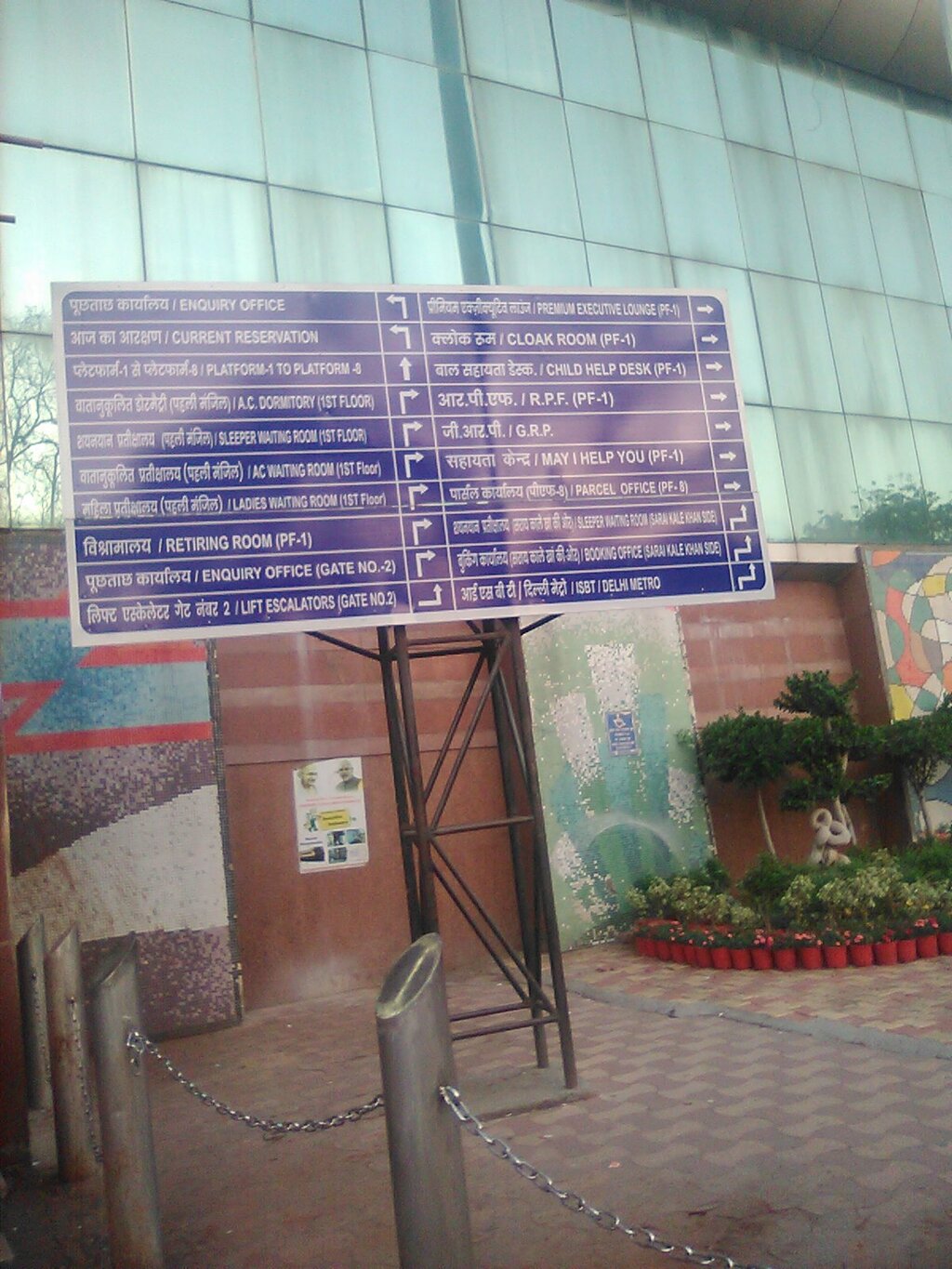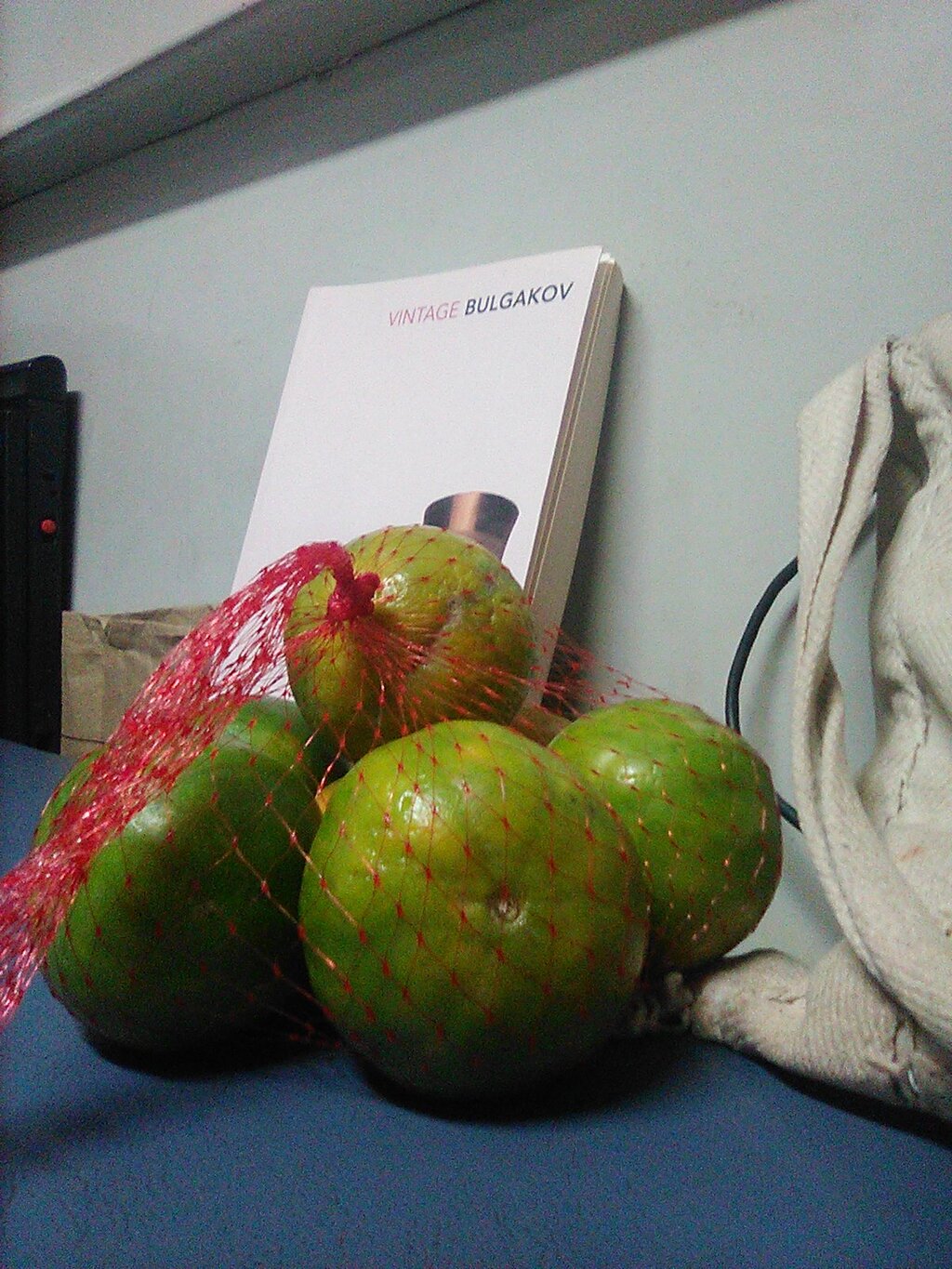Retiring Rooms
by Badri Sunderarajan · Sun 14 April 2024
It may be pertinent that when my friend Ravi and I were hunting for the Delhi Railway Station's retiring rooms, I had just finished reading Mikhail Bulgakov's Diaboliad, where the protagonist is sent on a nightmarish and never-ending quest through far-flung departments of Moscow's bureaucracy.
This was part of our trip to Delhi, Agra, and Jaipur, when, while searching for hotels, Ravi suggested the railway retiring room service as a more cost-effective option. These rooms are available to train travellers for up to 48 hours before and after their train journey. They are linked to the ticket's PNR number, and once you book your ticket on the IRCTC website, you can book corresponding retiring rooms on a dedicated sister website.
Since we had an early morning train to Agra from the Hazrat Nizamuddin railway station, we wanted to book a room there for the previous night. But the rooms were all sold out, as were the ones at New Delhi station where Ravi had stayed before. So we finally booked at Delhi railway station, which used to be the main railway hub before the newer stations came along. (IRCTC allows you to book rooms not just at your train's endpoints, but also at any reasonably nearby railway station, which is how we had the option to book for Delhi or New Delhi in addition to our boarding station of Hazrat Nizamuddin.)
When the day came, the two of us took a Yellow line metro to the Delhi station. We went to the station exit, but since we took a lift instead of the escalator we ended up at a slightly different place from what Ravi was familiar with. The only entry point had a truck parked outside with people milling around it, loading parcels. We later realised that it was the post office. Nobody questioned us as we walked in amidst the trolleys and packages, and upon exiting at the other side we found ourselves on the platform.
The Delhi railway station is unusual in that it has extra long platforms where trains can park in series, with two or occasionally three platform numbers on each physical platform. The post office exit led Ravi and myself onto Platform 5, along which we were directed to walk to find the waiting room on our left. Our journey took us past food stalls, a dark alcove with a lift inside, the actual entrance to the station, an upper-class waiting room, and a few other offices. At that point, Platform 5 turned into a mostly-deserted Platform 1, and there was still no retiring room in sight.
Walking back, we went and asked the security lady at the bag scanner, who said we had to go just a bit further to find it upstairs on our right. In order to speak to her, we had walked out past the scanner and come to what was technically outside the station. Perhaps she didn't notice that we had come from inside, but either way, she made us scan our bags before going back in, something which we had avoided the first time by going through the post office.
We returned to the platform and after a bit of hunting found a retiring room place, but it turned out to be only for dormitories, not for the individual rooms we'd booked. The person at the desk there directed us to go all the way down, exit the station, and ask at the counter outside; an instruction that turned out to be similar to the "Eighth floor, ninth corridor, flat 41, room 302" delivered to Mikhail Bulgakov's bewildered protagonist, Korotkov. The only counter we found outside after considerable hunting was the reservation counter, where a couple of bored officials told us to walk right outside the building to the "Jan Seva" counter. At this point we were almost outside the station and could even see the auto rickshaws ready to hail or be hailed by inbound passengers. Finally, we found a small door near the wall. It led to an office that was not labelled "Jan Seva" or anything of the sort but it turned out to be the correct place.
Here there was a slight hitch because while I had a QR code scan with all the reservation details, the official insisted on seeing "The PDF". Ravi told me later that retiring room officials usually want to see the PDF, even though an SMS is enough for actual train tickets. Ravi had to act as an interpreter between me and the railway official, who said that he does not know even one word of English. Ravi told him not to say such things and asked him how passengers would feel if they came not knowing the local language.
Eventually, Ravi pulled out his laptop and we logged into the IRCTC website to download the PDF version of our retiring room booking. Upon seeing The PDF, the official's entire demeanour changed: he suddenly became very helpful and wrote out our receipt in a jiffy, even providing us with detailed directions to our final destination.
We went back to the station, after scanning our luggage once again—Ravi remarked that since we skipped the bag check the first time, we are now having to do it multiple times. The retiring rooms turned out to be beyond the dark alcove with a lift inside that we had seen on our way in: in fact, upon stepping inside we saw the characteristic blue signboard announcing "Retiring Rooms" . Ravi was a bit sceptical of the state of the lift, but the staircase nearby seemed only to lead to the porters' quarters. Eventually, a porter came by and, confidently walking into the rundown lift, showed us up to a dark passageway where three officers were whiling away their time around a ledger-burdened table. They soon let us through, thanks to the magical PDF. Surprisingly, they wanted to see my Aadhaar card for identification even though I had entered my PAN details during registration. (My PAN is shorter, and therefore easier to remember, than my Aadhaar number).
Unlike Korotkov's tale, ours had a happy ending. We were rewarded for our troubles with a grandly spacious room which, though rough around the edges, was clean and well maintained. A desk stood in one corner, beneath a row of plug points. A little distance away was a large double-bed. Large as the bed was, the room was even larger, and could have fit two or three double-beds of similar size. I could even imagine a fourth fitting into the bathroom that came attached, though that might have been a tight squeeze.

We put down our bags and kept our devices to charge. There was some problem with the toilet cistern, but we got it working by adjusting the valves. The bathroom also had an attached geyser. Ravi took advantage of this with a shower. We sat and downloaded The PDFs of our future retiring room tickets, to make the process smoother next time. The large double-doors of our room were lockable, but we were expected to bring our own lock. Ravi had anticipated this from his prior experience with retiring rooms and brought one along.

We put our laptops back into our bags "just in case", took our depleted water bottles for refilling, and locked up the room. On the way down, we discovered the staircase on the opposite side of the lift from where we had been searching.

We thought it would be useful to map all these places in OpenStreetMap for future commuters, but indoor mapping is not an easy task and we were already half asleep. Even finding the station gate again felt like a long task, let alone mapping how to get there.
So we went down the stairs, walked along the platform in the opposite direction, and exited through the post office for dinner.
The Delhi retiring room experience was more exception than rule. Every other retiring room Ravi and I stayed in on this trip could be located easily, thanks in part to prominent signs that were displayed on the platform itself, rather than hidden in an alcove. The check-in procedure was similar everywhere though each place had its own peculiarities; the rooms similarly varied from place to place, despite being theoretically standardised.
Agra Cantt
We had not originally planned to book a room in Agra. We had tried initially, but the only rooms available were to dormitories that were quite expensive—coming to ₹400 for 12 hours for a single person rather than the ₹238 we paid in Delhi for a double room. Instead of that, the plan was to arrive in Agra in the morning, finish our sightseeing, and then take an overnight train to sleep in. (The destination of the night train was secondary: we chose Jaipur but it could just as well have been Bhopal.)
But since we'd had a late night, we thought it'd be better to book a room in Agra as well and catch up on sleep before venturing out. Since the rooms were sold out, we went for two AC dormitory beds, which we booked early in the morning and subsequently nearly missed our train. Fortunately, the baggage check machine at Hazrat Nizamuddin station was out of order, so we could bypass it and save a few precious minutes. Upon reaching the platform we realised the train was late so we had a bit of extra time as well.
At Agra, we found the retiring rooms within minutes. The place was up a flight of stairs as before. At the top was a neat and well-maintained check-in counter, very unlike the dilapidated table in the darkness we had seen in Delhi. The other difference was that it was a single-stage check-in, unlike in Delhi where we had to first get a slip at a different counter and take that with us to be allowed into the room. We also realised that the Agra rooms were not run by Indian Railways or IRCTC, but sublet to a private hospitality firm.
All this seeming professionalism made sense, because Agra would be more geared to tourists. Of course, this also meant the service was a bit more expensive. It was also more exposed to the surveillance state: the man at the counter wanted to see both our ID cards, even though the primary person's ID is officially enough. Again, he insisted on Aadhaar regardless of what ID I had registered with, making the filling of ID card type and number somewhat otiose. The reason they gave me that they wanted an address proof, not just an ID proof. Ravi showed his passport, which was accepted instead.
More alarmingly, the receptionist took colour printouts of our IDs before returning them to us. In theory these copies are stored and disposed of in a secure fashion, but they are only printed on one side of the paper and I have often got the Aadhaar details of random people on the back of grocery shop bills.
I had expected a "dormitory" to mean large shared rooms with multiple beds. What we actually got were individual private cells. Though smaller than the Delhi retiring room's bathroom, they were comfortable and cosy with a bed taking up an entire yellow wall and a small side-table with drawer next to it. The plug points were above the side table and conveniently right next to the bed (perforce, because all points in that room are "right next to the bed", but this place was especially convenient). The "AC" wasn't very noticeable, but small ceiling fans made up for what the AC failed to provide. Unlike in Delhi, the rooms were already equipped with locks and keys, so we didn't have to take our own.

While the rooms had separate walls, they did feature a grilled gap on top where you could see over into the next room. My room was at the end so I only had Ravi as a neighbour, but he would have had another neighbour on the other side. It was convenient for us because we could talk across the barrier without having to crowd into the same room.

The bathrooms were in a separate zone, dormitory style. They had toilets and actual bath areas separately, which was nicer: they were all in a row with three of each type. There was no geyser, but that didn't matter much since it was so hot outside anyway. We stayed in the rooms until lunch time, at which point we locked our bags inside and proceeded to the Taj Mahal, a story which Ravi has written about separately.
Jaipur Jn.
The Jaipur retiring room dormitories were very similar to the ones at Agra Cantt. Unfortunately, there were two sets of rooms, and Ravi and I got placed in different ones. Note to future travellers: rooms D16 and D17 are not physically adjacent.
The Jaipur dormitories were operated by IRCTC, and besides The PDF my ID card alone was enough to get us in—but again, it was the Aadhaar and not the PAN that they wanted to see. We arrived early in the morning and immediately went to sleep so I don't remember much more of the check-in process. Like in Agra, we were provided with keys to corresponding locks for our individual dormitories.
My group of dormitories came with a shared bathroom, but this time it was a large room with a Western style toilet in one corner. It didn't seem very clean so I was glad I had already had my bath in Agra.
We were scheduled to check out at 10am. I had locked up my room and was helping Ravi pack when one of the staff came round and said they had to ready the room for the next person. I gave him my keys and he was okay giving us a few more minutes to finish packing. We eventually handed over Ravi's keys at the check-out counter itself.

This time, since we hadn't booked rooms for the whole day, we had to carry our bags with us. Ravi said we could also leave them behind in the Cloak Room, another service provided by the station. But that would require our bags to be locked, and Ravi's rucksack was unfortunately not lockable. We considered moving some things into my backpack and locking it but finally decided it wasn't worth the trouble.
Hazrat Nizamuddin, Delhi
This was my last retiring room on this trip. Ravi had already gone home and I had an early morning train back to Salem, so I had booked a single dormitory bed for the night.
I had to search a bit to find my room here but it was fortunately much easier than in Delhi. I reached the station some time before my check-in time of 8pm, so I spent some time exploring the platform and catching up on Mikhail Bulgakov's The Fatal Eggs while charging my phone. On the way, I noticed two doors marked "Retiring Room" opening out onto Platform 1. One had a lock and the other was unlocked. I guessed that they must be the double bedrooms - if so, it would explain why they were sold out, since there were only two unlike the at least half a dozen we saw in Delhi.
When the time came, I went to the retiring room reception counter that I had found in the opposite direction, which also happened to be a general help desk. I heard a couple of people before me enquiring about booking a room on the spot, and the receptionist explained to them that no, you have to book it online the same way as your ticket. When my turn came I showed him my reservation PDF. It seemed like he'd never used a button phone before, because I had to teach him how to scroll using the directional buttons, but once he figured it out he was able to read the details he wanted and give me a receipt.
He directed me to an upstairs area that was outside the baggage-check entry gates. I later realised it's the same level as the overbridge that leads to the platforms. One can walk out of the retiring room area continue for a few metres, and then turn right to scan your bag and enter the platform, or turn left to go down the stairs and exit the station.

The dormitory this time was more like an actual dormitory. It was essentially a large hall with two rows of about four beds each. One wall hosts doors to the ladies' and gents' bathrooms on opposite ends, while on the other side next to the door is the desk belonging to the receptionist-cum-watchman.
After seeing my slip and PDF, which he navigated with an expert hand, the receptionist made me fill out my details in a ledger, and then told me to make myself comfortable—have a bath, change, whatever I wanted. There was no locker to keep my bag, but an elderly lady who was also in the room advised me to keep it on the side of the bed further away from the door. The plug point near my bed was plastered up due to water leakage, apparently, but they said I could use the plug point of the opposite bed.
I went for a bath in a spacious bathroom, similar in size to the Delhi Railway station one but with an extra space outside containing a urinal and a pair of wash basins as a bonus. When I came out, there was a new watchman on duty; he said I could leave my bag when I went out for dinner but to keep my laptop and other valuables with me. He also pointed out a more nearby plug point that was more convenient, although I had to make sure people didn't trip over my laptop's charging cable while going to the ladies' bathroom.
While in the retiring room, I saw quite a few people coming in and trying to book new beds, often arguing with the watchman saying they saw so many beds empty. The watchman had to keep explaining to them that bookings happen online only and that the existing beds have already been reserved. It looks like the retiring room service is well known here but people are not very informed on how it works.
The room eventually filled up with one man and two families with children. They all seemed very at home in the retiring room, unpacking and settling down or if they were in a private hotel room and not a more public dormitory. Come to think of it, this is the same at-home feeling that permeates in long-distance train journeys as well. The watchman joined in, warning one mother to make sure her child doesn't go near the plug points, and catching a quick nap on one of the empty-but-reserved beds during a free moment.

